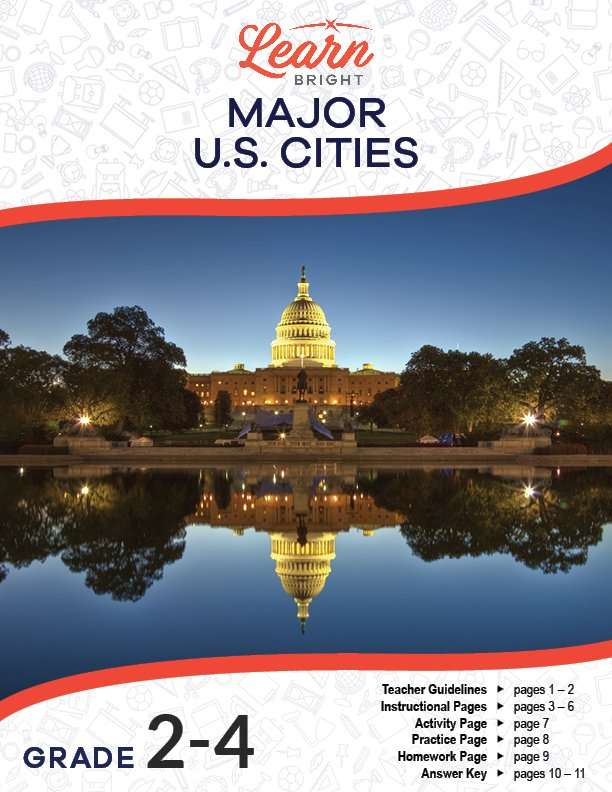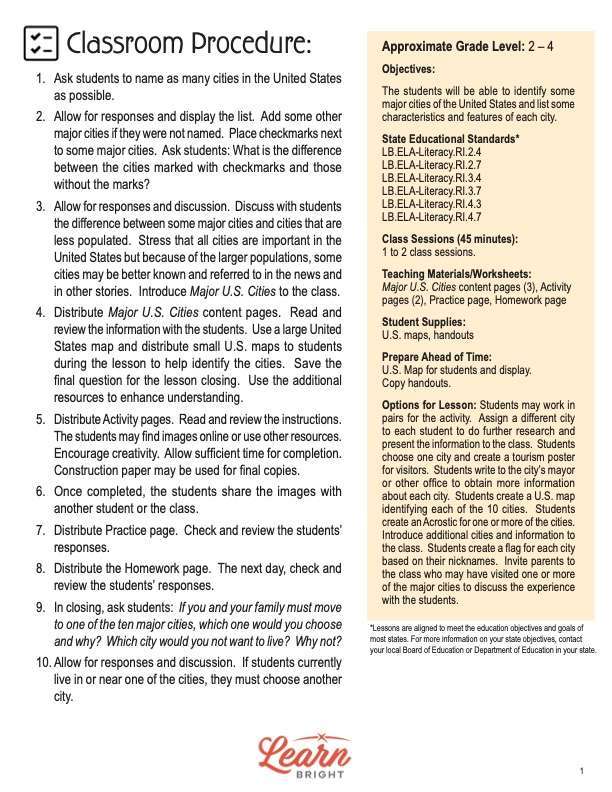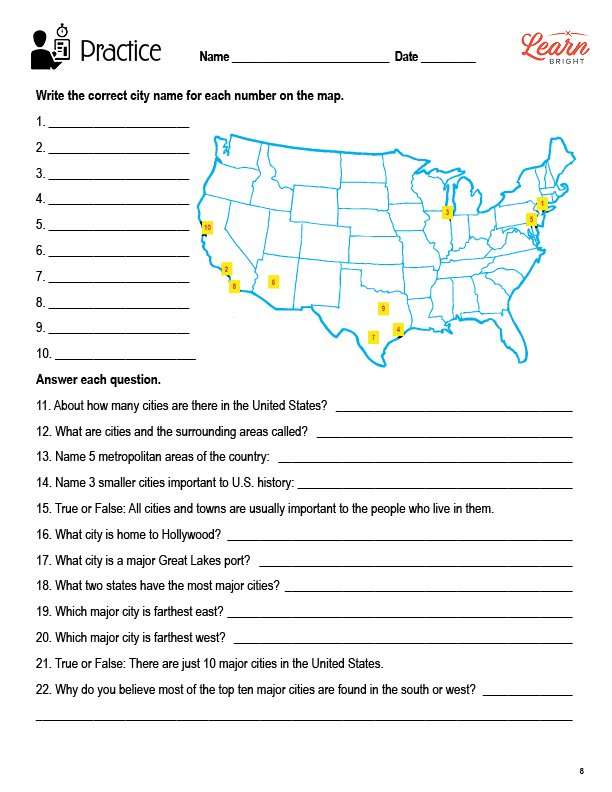Description
What our Major U.S. Cities lesson plan includes
Lesson Objectives and Overview: Major U.S. Cities teaches students some facts about some of the most populated cities in the United States. Students will be able to identify these cities and list some of the traits and features of each one. They will discover that people refer to cities as major cities when they have large populations or great influence on the country it is in or on the world. This lesson focuses on the top 10 most populous U.S. cities. This lesson is for students in 2nd grade, 3rd grade, and 4th grade.
Classroom Procedure
Every lesson plan provides you with a classroom procedure page that outlines a step-by-step guide to follow. You do not have to follow the guide exactly. The guide helps you organize the lesson and details when to hand out worksheets. It also lists information in the yellow box that you might find useful. You will find the lesson objectives, state standards, and number of class sessions the lesson should take to complete in this area. In addition, it describes the supplies you will need as well as what and how you need to prepare beforehand. Ensure you obtain maps of the United States.
Options for Lesson
In the “Options for Lesson” section of the classroom procedure page, you will see some suggestions for additional activities or ideas to add to the lesson if you want to. Students may work in pairs for the activity. Assign a different city to each student to do further research and present the information to the class. Students choose one city and create a tourism poster for visitors. Have students write to the city’s mayor or other office to obtain more information about each city. Students create a U.S. map identifying each of the 10 cities. They create an acrostic for one or more of the cities. Introduce additional cities and information to the class. Students create a flag for each city based on their nicknames. Invite parents to the class who may have visited one or more of the major cities to discuss the experience with the students.
Teacher Notes
The teacher notes page provides an extra paragraph of information to help guide the lesson and remind you what to focus on. It explains that the goal of the lesson is to teach students about the significance of these cities in history. The blank lines on this page are available for you to write out thoughts and ideas you have as you prepare the lesson.
MAJOR U.S. CITIES LESSON PLAN CONTENT PAGES
Introduction to the Major U.S. Cities
The Major U.S. Cities lesson plan contains four pages of content. There are thousands of cities in the United States. Some cities have millions of people, and other cities may have just a few hundred people or fewer. In fact, the smallest town in the United States may be Buford, Wyoming, with a population of just one person. The small town includes a single house, gas station, and post office. And of course, the largest city in the U.S. is New York, New York, with a population of nearly 9 million people and with many more gas stations, homes, and post offices.
Regardless of the number of people in a town or city, all cities and towns are important to the people who live there or who may visit. Most likely, you have visited other cities in your state or in other states. The city you live in now may be small or large, but you and everyone who lives there calls it home.
Though all cities have many of the same things, like schools, houses, businesses, parks, roads, and much more, there are some cities that we call major cities. Major cities of the United States usually include those with very large populations. In addition, major cities have been important in the history of the state or country, and they likely have a diverse population.
What Are the Major Cities in the United States?
We often hear the names of major cities in the United States on television, in movies, in books, in news stories, and other places. You may be familiar with them yourself, but you may not know their history. Since there are nearly 20,000 cities in the United States, not every one is considered a major city.
The lesson lists the top 10 major cities in the United States by population. And the number of that population includes only the people living inside the borders of the city. This list includes Dallas, Philadelphia, Los Angeles, and Phoenix. Other places in the United States with large populations called metropolitan areas count the populations in the surrounding areas of the city. Other very populous cities include Boston, Miami, Detroit, and Seattle.
You might live in or near one of these populous cities. Perhaps you have visited one or more of the areas. We could call all of these major cities of the United States. Of course, there are smaller cities too that were important to the history of the country. Such places include Jamestown and Williamsburg in Virginia, Charleston in South Carolina, and New Orleans in Louisiana.
Interesting Facts
The last couple content pages offer some interesting facts about each major city. New York City is the most famous city in the world and influences the world in areas such as politics and finance. Los Angeles is next with a population of nearly 4 million people. The City of Angels started out with just 44 people, but the extension of the railroad helped it grow quickly.
Chicago, IL, was founded in 1833 and stretches for 22 miles along Lake Michigan. A fire in 1871 destroyed about four square miles of the city. Once the capital of the Texas Republic, Houston is the fourth largest at almost 2.3 million residents. It is also home to NASA’s Johnson Space Center. Hence, it has the nickname of Space City.
Next is Philadelphia, the City of Brotherly Love, which was founded by William Penn in 1682. This city was once a refuge for the Quakers, and it once served as the capital of the country. Known as the Valley of the Sun, Phoenix, Arizona, is the capital of its state. It rests close to the Sonora Desert, one of the hottest deserts in North America.
San Antonio has the nickname Alamo City, and it’s one of the fastest growing cities in the United States. San Diego was colonized by Spain in the late 18th century. The U.S. seized it following the Mexican War in 1846. Back to Texas, Dallas is the ninth largest city. It is home to several colleges and universities. Finally, San Jose was once the state capital for a few years. People often refer to it as the Capital of Silicon Valley.
As you can see, the two states with the most major cities are California and Texas with three each. In fact, the two most populated states in the United States include California and Texas. Interestingly enough, seven major cities reside in the southern and western regions of the United States. Which city would you want to live in?
MAJOR U.S. CITIES LESSON PLAN WORKSHEETS
The Major U.S. Cities lesson plan includes three worksheets: an activity worksheet, a practice worksheet, and a homework assignment. Each one will help students solidify their grasp of the material they learned throughout the lesson. You can refer to the classroom procedure guidelines to know when to hand out each worksheet.
DRAW THE SYMBOLS ACTIVITY
For the activity worksheet, students will draw an image that represents a city. They will base the pictures on the cities’ nicknames. Students will work alone for this activity. However, you are welcome to let them work with partners or in small groups instead.
MAJOR U.S. CITIES PRACTICE WORKSHEET
The practice worksheet splits into two parts. For the first part, students must reference the map on the worksheet to find and name the 10 major cities. Then they will answer 12 questions about the cities using what they learned in the lesson. You can choose whether or not they can reference the content pages for help.
MATCH THE CITIES HOMEWORK ASSIGNMENT
For the homework assignment, students must match cities to the facts they represent. There are 20 statements for students to match. (They will use each city twice.)
Worksheet Answer Keys
The lesson plan provides answer keys for both the practice and homework worksheets. All the correct answers are in red to make it easy to compare them to your students’ responses. If you choose to administer the lesson pages to your students via PDF, you will need to save a new file that omits these pages. Otherwise, you can simply print out the applicable pages and keep these as reference for yourself when grading assignments.









